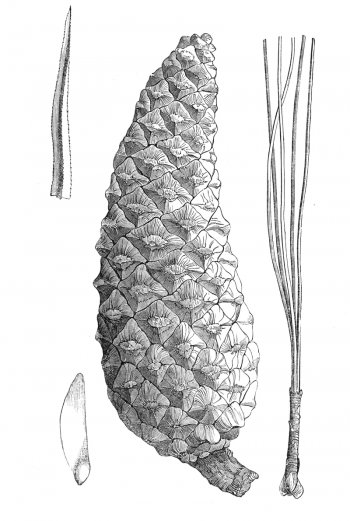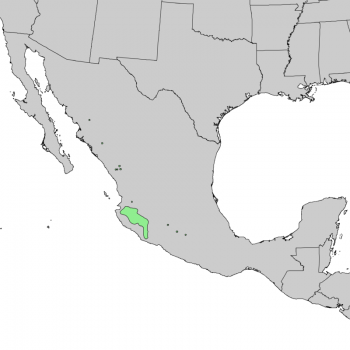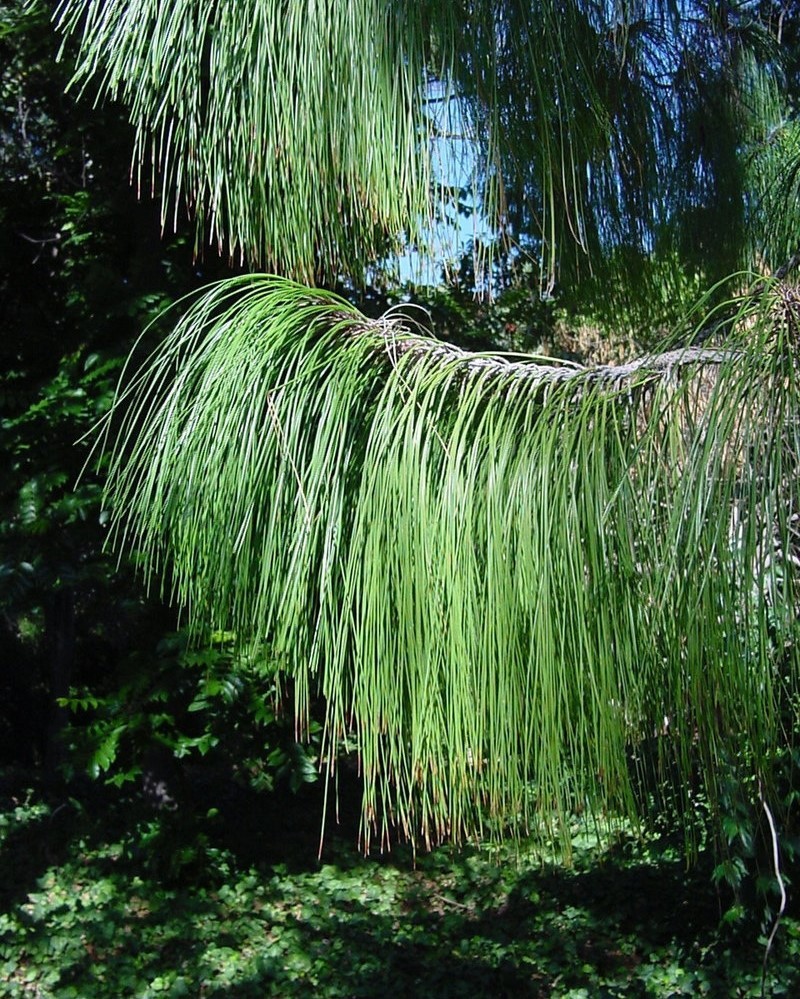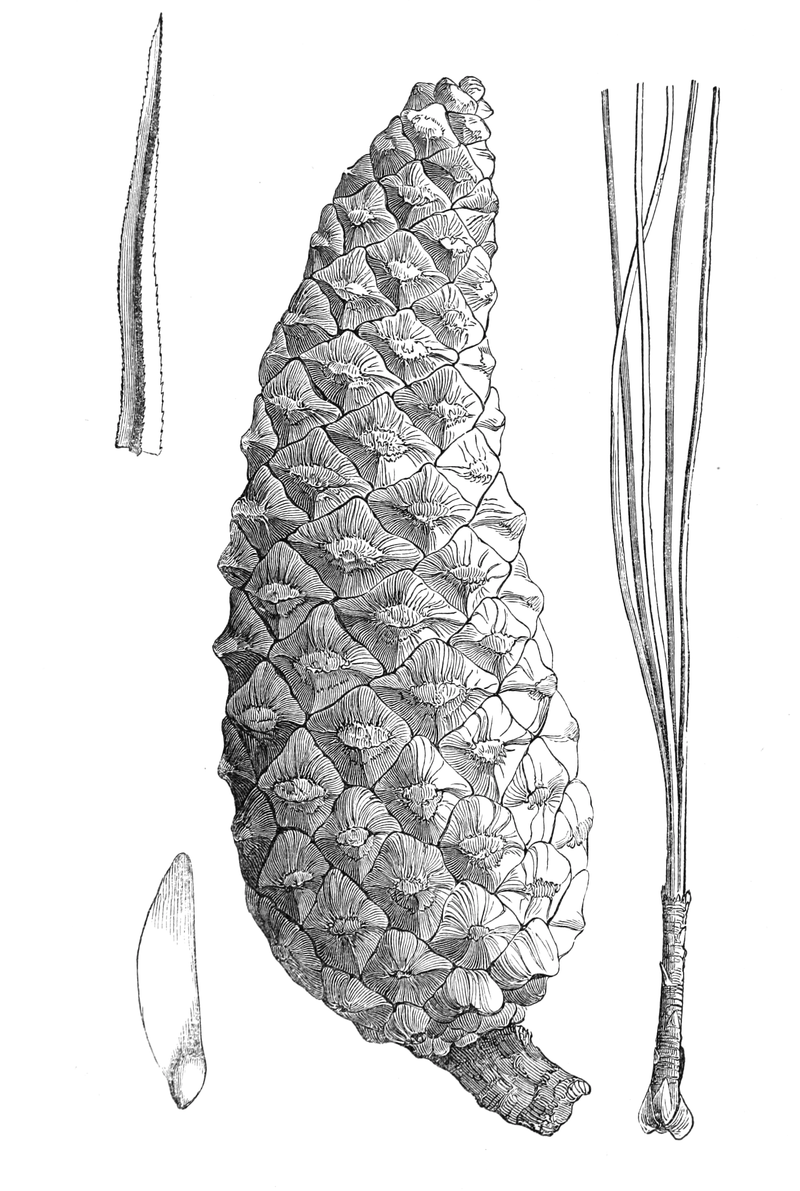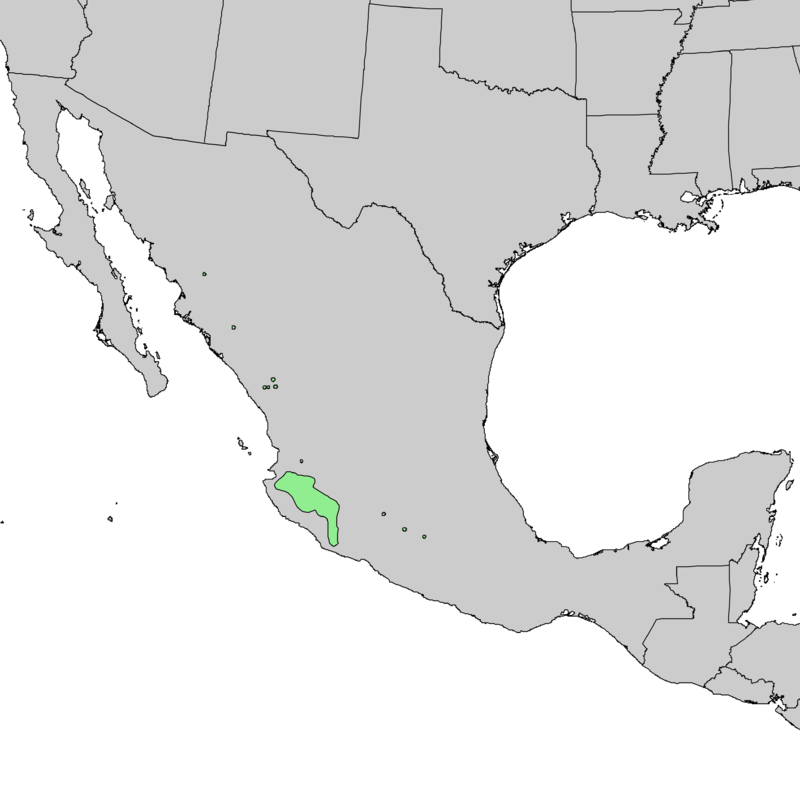subgenus Pinus, section Trifoliae (Duhamel), subsection Ponderosae (Louden).
Pinus douglasiana, first described in 1943 by Maximino MartÃnez (1888-1964), is commonly known as Douglas pine, as well as, simply Pino or ocote in the Spanish language. The species name honors Margaret Douglas, an enthusiast for Mexican flora who supported Martinez, who authored the species, in his work on Mexican pines.
Ethnobotany. An important timber tree within its range, typically logged with its companion trees in mixed stands.
Description. Douglas pine is an evergreen coniferous species of tree that grows to mature heights of 150feet (45 m) tall with a single straight, round trunk up to 40 inches (100 cm) in diameter, measured at breast height, that is typically clear of branches for 2-thirds of its length. The tree's crown pyramidal when young, becoming rounded with age, varying from dense to open.
- Bark is smooth and red-brown at first, later becoming rough and scaly, dividing into large, irregular plates separated by deep fissures.
- Shoots smooth or rough with prominent decurrent pulvini, colored dark brown, not glaucous.
- Foliar units form dense tufts. Fascicle sheaths measure 1 to 1.2 inches (25 - 30 cm) at first, weathering to 0.6 to 0.8 inch (15 - 20 mm), with 7 to 10 imbricate, bracteate, light lustrous brown scales with ciliate margins, weathering grayish brown, persisting for the life of the foliar unit.
- Leaves (needles) are borne in bundles of 5 to 7, often 6, persisting 2 to 2.5 years on the tree. They are usually lax and drooping, 6 to 14 inches (15 - 35 cm) long and 0.28 to 0.48 inch (0.7 - 1.2 mm) wide, colored light yellowish green to glaucous green, with an acute apex. Stomata on all faces of leaves, are arranged 3 to 4 lines on each face.
- Pollen cones are numerous, crowded near the basal end of a new shoot, cylindrical shaped, measuring 0.8 to 1 inch (20 - 25 mm) long and 0.16 to 0.2 inch (4 - 5 mm), colored pinkish brown at maturity.
- Seed cones form near the end of a new shoot in whorls of 1 to 4 on stout, recurved, 0.4 to 0.6 inch (10 - 15 mm) long peduncles which fall with the cone. Immature cones measure 2.8 to 4 inches (7 - 10 cm) long, colored purplish or glaucous. Mature cones ovoid when closed, often slightly curved, broadly ovoid with a flattened base when opened, then 2.8 to 4 inches (7 - 10 cm) long and 2 - 2.8 inches (5 - 7 cm) wide.
- Seed scales number 110 to 130, parting to release the seeds. They are thin, woody, light brown with often indistinct lighter marks of seed wings. Apophyses are nearly flat or raised and transversely keeled, radially striate or grooved, rhombic or pentagonal in outline, arranged nearly symmetrical around the cone, measuring 0.44 to 0.68 inch (11 - 17 mm) wide, colored light brown, reddish brown or dark brown. Umbos are raised, transversely rhombic in outline, measuring 0.2 to 0.28 inch (5 - 7 mm ) wide, darker in color than the apophysis, without a prickle.
- Seeds are obovoid shaped, flattened, measuring 0.16 to 0.2 inch (4 - 5 mm) long and 0.12 to 0.14 inch (3 - 3.5 mm) wide, colored light gray or brown, often with dark spots.
- Seed wings articulate, held to the seed by two oblique claws. They measure 0.72 to 0.96 inch (18 - 24 mm) long and 0.28 to 0.36 inch (7 - 9 mm) wide, colored light yellow-brown and translucent.
In most respects this species is very similar to
P. pseudostrobus. The cone peduncle falls with the cone in
P. douglasiana, but remains on the branch in
P. pseudostrobus. Also,
P. pseudostrobus has less drooping foliage than
P. douglasiana.
Distribution. This species is native to Mexico - mainly Jalisco, Michoacán, México, and northern Morelos, but extending north into Nayarit and the Sierra Medre Occidental crest between Sinaloa and Durango, and extending south locally into Guerrero and Oaxaca. It is found at elevations of 4,600 to 8,000 feet (1,400 - 2,500 m) above sea level, in warm to temperate climates with annual precipitation of about 40 inches (1,000 mm). Occurs mostly in mixed pine and pine-oak forests.
Hardy to USDA Zone 7 - cold hardiness limit between 0° and 10°F (-17.7° and -12.2°C).
